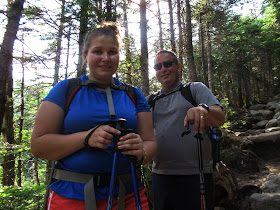 |
| Some of us just don't like the heat. |
 |
| Every time this family stops to rest the girl takes out her cell phone and checks her messages. |
 |
| Cool, sweet Gem Pool. |
 |
| Another pair coming down from the hut. Most of the people I talked to today were hiking Mt. Washington for the first time. That's kind of astounding. |
 |
| A truly enchanted part of the trail just below tree line. |
 |
| The water level of the large lake is several inches low but still within a range of normal for this period of the summer. |
 |
| Trying to get an in-focus photo of these Mt. Avens blossoms on their thin stalks as they bobbed and weaved in the wind was irksome. |
 |
| I sorted it out by taking a photo of an entire clump of Mt. Avens growing in a tuft of Deer's Hair, (Scirpus cespitosus), which is a common sedge in the alpine zone. |
 |
| Another great character out enjoying a lovely summer day. |
 |
| Summer and winter this part of the Crawford Path, as it begins its ascent of the steep summit cone of Mt. Washington offers some of the finest views in the White Mountains. |
 |
| Ben Kimme, naturalist at Lakes of the Clouds, packs down part of Saturday's requisiton... |
 |
| The forest on the head wall of Ammonoosuc Ravine. |
 |
| An anxious group. They'd set out to reach the hut but because of the heat and the steep trail they were having second thoughts about continuing. It was their first hike in the White Mountains. |
 |
| Jumping into Gem Pool. |
 |
| This was a first for me to find a large group of people swimming in Gem Pool. I have jumped in and jumped right back out again to cool off but they were fully enjoying the cold water. |

















I like your people photos and comments - did not wonder about it at all
ReplyDelete